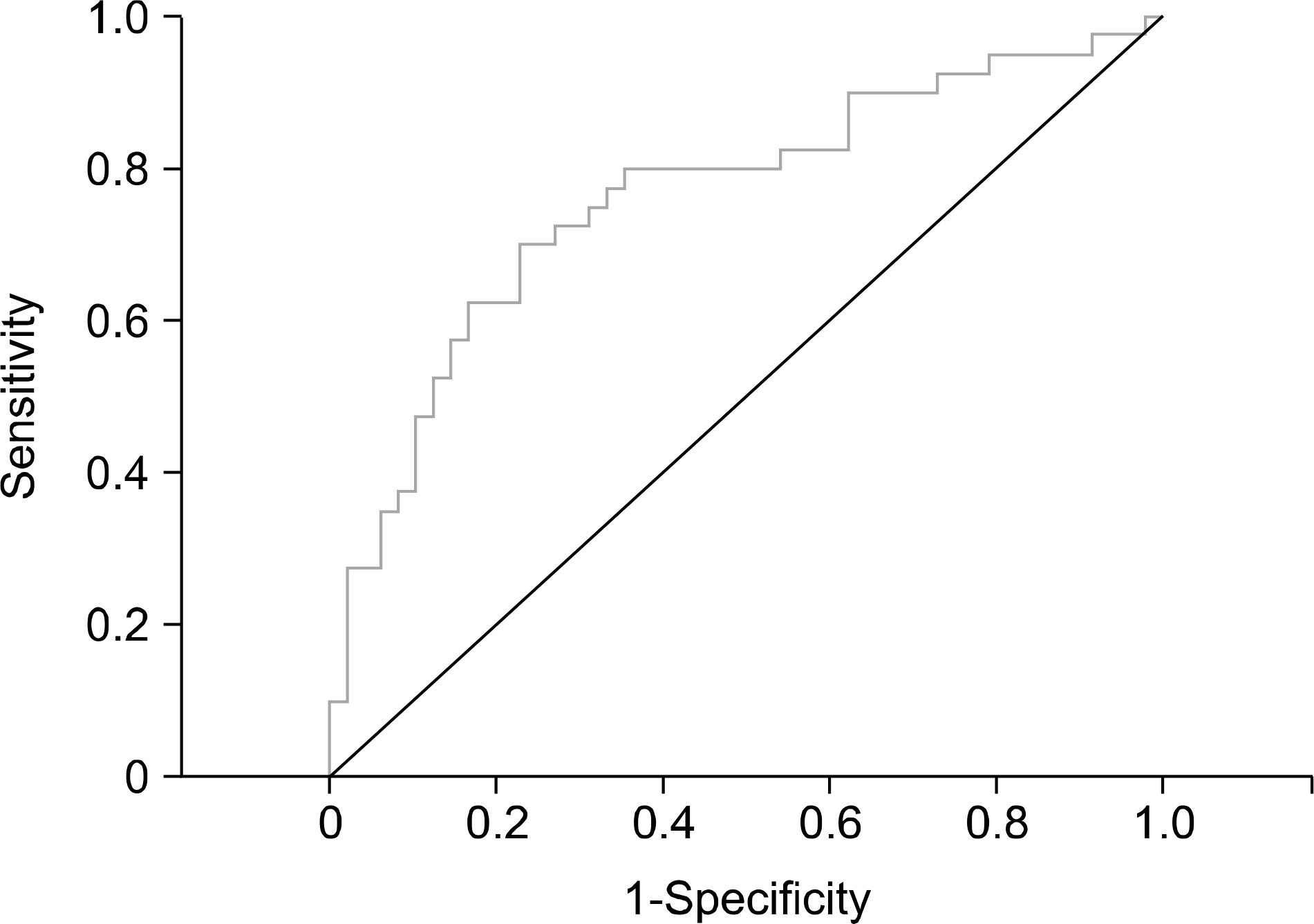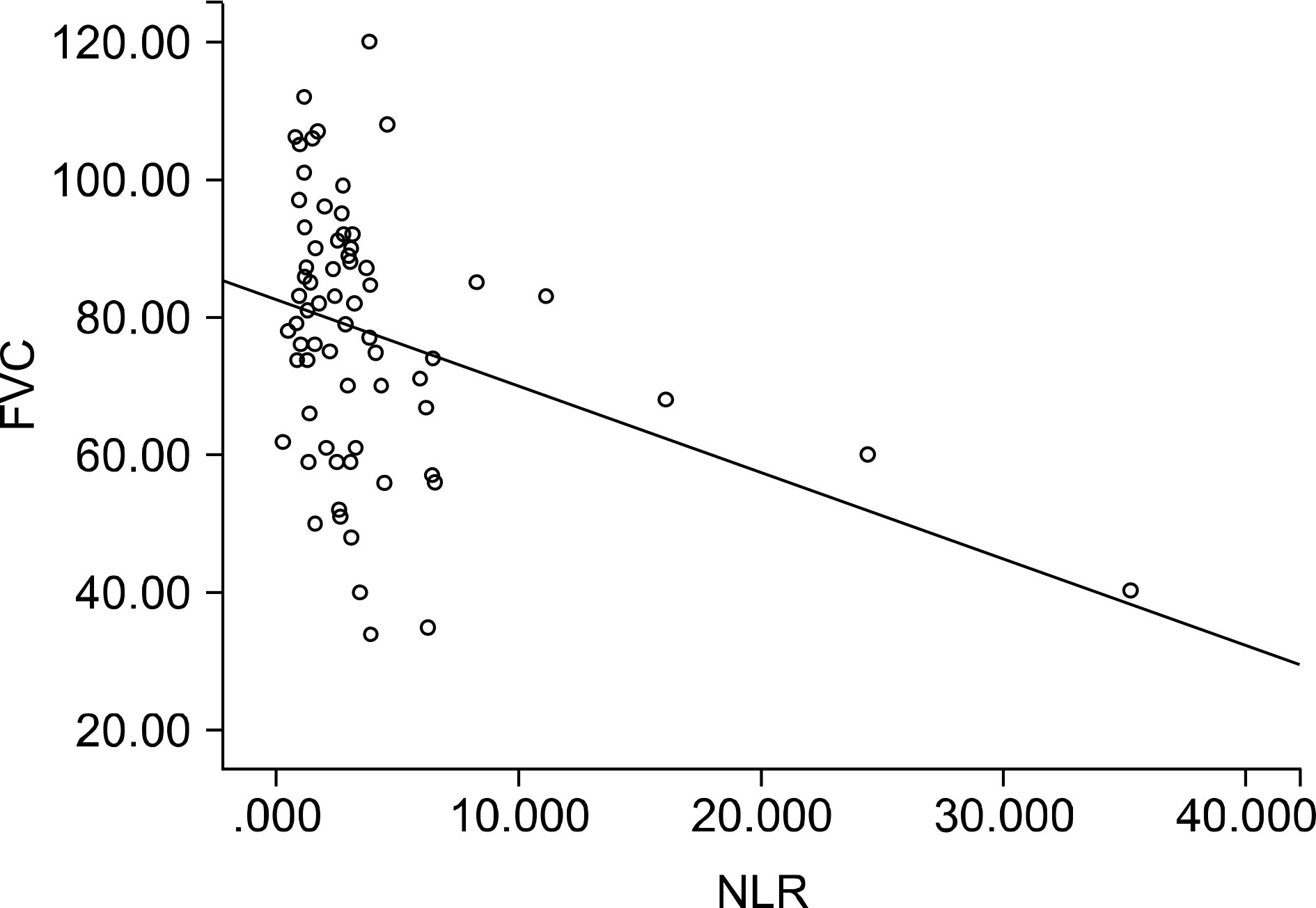Abstract
Objective
The neutrophil-to-lymphocyte ratio (NLR) is elevated in inflammatory diseases, but its clinical significance in systemic sclerosis (SSc) is unclear. This study evaluated NLR in diagnosing SSc and in predicting lung involvement such as interstitial lung disease (ILD).
Methods
The medical records of 88 patients with SSc and 50 healthy controls were reviewed. Exclusion criteria included active infection or the presence of any hematological, cardiovascular, or metabolic disorder. The NLR was compared between patients with SSc and healthy controls, and associations between NLR and lung involvement were analyzed.
Results
The NLR was significantly higher in patients with SSc compared to healthy controls (NLR, 3.95±6.59 vs. 2.00±1.07, p<0.01). Patients with SSc and ILD had higher NLR levels than those without ILD (p<0.01, p<0.05). NLR was negatively associated with forced vital capacity (r=−0.341, p<0.01), but not with diffusing capacity for carbon monoxide. Receiver-operating characteristics analysis of NLR to predict ILD in patients with SSc showed that the area under the curve was 0.763. The cut-off NLR value for prediction of lung involvement was determined to be 2.59 (sensitivity, 0.700; specificity, 0.729; p<0.01).
Go to : 
REFERENCES
1. Merkel PA, Clements PJ, Reveille JD, Suarez-Almazor ME, Valentini G, Furst DE. OMERACT 6. Current status of outcome measure development for clinical trials in systemic sclerosis. Report from OMERACT 6. J Rheumatol. 2003; 30:1630–47.
2. Steen VD, Conte C, Owens GR, Medsger TA Jr. Severe restrictive lung disease in systemic sclerosis. Arthritis Rheum. 1994; 37:1283–9.

3. Zahorec R. Ratio of neutrophil to lymphocyte counts–rapid and simple parameter of systemic inflammation and stress in critically ill. Bratisl Lek Listy. 2001; 102:5–14.
4. Ahsen A, Ulu MS, Yuksel S, Demir K, Uysal M, Erdogan M, et al. As a new inflammatory marker for familial Mediterranean fever: neutrophil-to-lymphocyte ratio. Inflammation. 2013; 36:1357–62.

5. Núñez J, Núñez E, Bodí V, Sanchis J, Miñana G, Mainar L, et al. Usefulness of the neutrophil to lymphocyte ratio in predicting long-term mortality in ST segment elevation myocardial infarction. Am J Cardiol. 2008; 101:747–52.

6. Gibson PH, Croal BL, Cuthbertson BH, Small GR, Ifezulike AI, Gibson G, et al. Preoperative neutrophil-lymphocyte ratio and outcome from coronary artery bypass grafting. Am Heart J. 2007; 154:995–1002.

7. Li L, Xia Y, Chen C, Cheng P, Peng C. Neutrophil-lympho-cyte ratio in systemic lupus erythematosus disease: a retrospective study. Int J Clin Exp Med. 2015; 8:11026–31.
8. Qin B, Ma N, Tang Q, Wei T, Yang M, Fu H, et al. Neutrophil to lymphocyte ratio (NLR) and platelet to lymphocyte ratio (PLR) were useful markers in assessment of inflammatory response and disease activity in SLE patients. Mod Rheumatol. 2016; 26:372–6.

9. Sekeryapan B, Uzun F, Buyuktarakci S, Bulut A, Oner V. Neutrophil-to-lymphocyte ratio increases in patients with dry eye. Cornea. 2016; 35:983–6.

10. Hu ZD, Sun Y, Guo J, Huang YL, Qin BD, Gao Q, et al. Red blood cell distribution width and neutrophil/lymphocyte ratio are positively correlated with disease activity in primary Sjögren's syndrome. Clin Biochem. 2014; 47:287–90.

11. Preliminary criteria for the classification of systemic sclerosis (scleroderma). Subcommittee for scleroderma criteria of the American Rheumatism Association Diagnostic and Therapeutic Criteria Committee. Arthritis Rheum. 1980; 23:581–90.
12. van den Hoogen F, Khanna D, Fransen J, Johnson SR, Baron M, Tyndall A, et al. 2013 classification criteria for systemic sclerosis: an American College of Rheumatology/European League against Rheumatism collaborative initiative. Arthritis Rheum. 2013; 65:2737–47.

13. Ghang B, Kwon O, Hong S, Lee CK, Yoo B, Kim YG. Neutrophil-to-lymphocyte ratio is a reliable marker of treatment response in rheumatoid arthritis patients during tocilizumab therapy. Mod Rheumatol. 2017; 27:405–10.

14. Atilla N, Yı ldı rım Çetin G, Balkarlı A. Association of neutrophil/lymphocyte ratio with the degree ofinterstitial lung disease in systemic sclerosis. Turk J Med Sci. 2016; 46:1871–4.

15. Oehadian A, Suryadinata H, Dewi S, Pramudyo R, Alisjahbana B. The role of neutrophyl lymphocyte count ratio as an inflammatory marker in systemic lupus erythematosus. Acta Med Indones. 2013; 45:170–4.
16. Herzog EL, Mathur A, Tager AM, Feghali-Bostwick C, Schneider F, Varga J. Review: interstitial lung disease associated with systemic sclerosis and idiopathic pulmonary fibrosis: how similar and distinct? Arthritis Rheumatol. 2014; 66:1967–78.

Go to : 
 | Figure 1.Receiver operating characteristic (ROC) curve for the neutrophil/lymphocyte ratio (NLR) to predict interstitial lung disease (ILD) involvement. Receiver-operating characteristics analysis of NLR to predict ILD showed that the area under the curve was 0.763. The cutoff value using the ROC curve was 2.59 (sensitivity, 0.700, specificity, 0.729; p<0.001). |
 | Figure 2.Correlation between neutrophil/lymphocyte ratio (NLR) and forced vital capacity (FVC). The NLR was negatively correlated with FVC, with a correlation coefficient of −0.341 (p=0.004). |
Table 1.
Demographic and baseline clinical characteristics of patients with systemic sclerosis (SSc) and healthy groups




 PDF
PDF ePub
ePub Citation
Citation Print
Print


 XML Download
XML Download